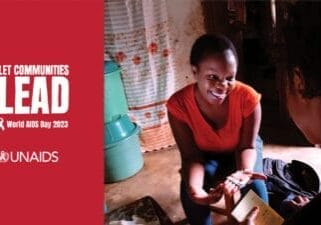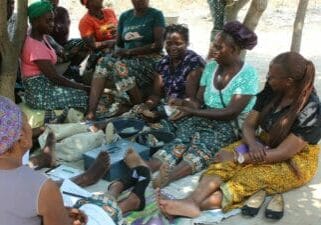News > Blog
Promoting Evidence-Based Approaches to HIV: Our Posters at AIDS 2024
Published 09/10/2024 by Global Communities
By Paula Rudnicka, Sr. Manager for Public Affairs

In July 2024, more than 11,000 people attended AIDS 2024 – the largest gathering on HIV and AIDS in the world. Global Communities and our subsidiary IntraHealth International showcased our work through five posters, which highlighted the results of studies conducted by our HIV projects in Central America, Botswana and South Sudan:
- Exploring Health Provider Knowledge of the Undetectable Equals Untransmittable (U=U) Concept in Central America.
- From Policy to Practice: the HIV Care and Treatment Project’s Experiences in Transitioning to an Optimized Regimen in Honduras.
- Testing Outcomes of HIV-Exposed Infants in Botswana.
- Using Behavioral Change Communications Intervention to Create Demand and Enhance PrEP Uptake in South Sudan.
- Validation of Knowledge, Attitudes and Practices of Pre-Exposure Prophylaxis (KAPREP) among Key Populations in Honduras: A New Tool.
After the event, I asked our staff to share key takeaways from these studies. The following colleagues participated in the exchange: Betty Adera, Sr. Technical Advisor for HIV/AIDS & Health, Global Communities; Dr. Mario Luis Cooper Medina, Director of Health Programs, Honduras, Global Communities; María Inés Castañeda, Sr. Officer of Qualitative Research, Guatemala, IntraHealth; José Eduardo Abdo, Laboratory Specialist, Guatemala, IntraHealth; and Gladys Achan, Communications Officer, South Sudan, IntraHealth.
The conversation was edited for length and clarity.

Paula: You all developed posters for the 25th International AIDS Conference. Could you provide a brief overview of the research questions and key findings?
 María: IntraHealth is a longtime pioneer in solving global health challenges. We focus on strengthening health systems and improving the performance of health workers. In 2018, we began leading the HIV Care and Treatment Project in Central America, specifically in Guatemala, Honduras, El Salvador and Panama. Funded by the United States Agency for International Development (USAID), the project strengthened the capacity of HIV health clinics and non-governmental organizations to implement evidence-based interventions along the HIV continuum of care to reach epidemic control at the local level. The primary goal was to reduce barriers to HIV treatment adherence among key populations. Both José and I supported the project, and now we support the follow on. We have led several studies to ensure our interventions are evidence-based.
María: IntraHealth is a longtime pioneer in solving global health challenges. We focus on strengthening health systems and improving the performance of health workers. In 2018, we began leading the HIV Care and Treatment Project in Central America, specifically in Guatemala, Honduras, El Salvador and Panama. Funded by the United States Agency for International Development (USAID), the project strengthened the capacity of HIV health clinics and non-governmental organizations to implement evidence-based interventions along the HIV continuum of care to reach epidemic control at the local level. The primary goal was to reduce barriers to HIV treatment adherence among key populations. Both José and I supported the project, and now we support the follow on. We have led several studies to ensure our interventions are evidence-based.
 My poster was titled “Exploring Health Provider Knowledge of the Undetectable Equals Untransmittable (U=U) Concept in Central America.” When a person living with HIV adheres to their antiretroviral treatment (ART) and reaches an undetectable viral load, they can no longer transmit HIV to another person. They are not cured, but the virus is no longer replicating in their bodies, which has many positive health and psychosocial implications. For example, they are at lower risk for developing opportunistic infections and they are more confident to reengage in intimate relationships and even start families.
My poster was titled “Exploring Health Provider Knowledge of the Undetectable Equals Untransmittable (U=U) Concept in Central America.” When a person living with HIV adheres to their antiretroviral treatment (ART) and reaches an undetectable viral load, they can no longer transmit HIV to another person. They are not cured, but the virus is no longer replicating in their bodies, which has many positive health and psychosocial implications. For example, they are at lower risk for developing opportunistic infections and they are more confident to reengage in intimate relationships and even start families.
Although the U=U concept is scientifically proven, it is not widely known in our region, so we conducted an exploratory survey in HIV clinics to examine health providers’ knowledge and attitudes about it. We have found that some health workers believe that U=U is a fact, while others misunderstand it, which prevents them from sharing this information with their patients. There are also providers who truly believe in the U=U science but are either afraid of being held responsible for potential HIV infections or worry that their patients would engage in unsafe sex, leading to a spike in other sexually transmitted infections.
Our recommendation is to sensitize health workers to promote the U=U messaging in their communities. Also, national governments in Central America should issue official policies endorsing the message.

Betty: Well said, Maria! I would like to underscore that U=U messaging is one of the best strategies for motivating people to get tested and adhere to their treatment regimens. It is very important for people to know they can live full, happy lives when they are HIV-positive. This awareness will get us closer to the 95-95-95 targets established by the Joint United Nations Programme on HIV/AIDS (UNAIDS). These targets will be achieved when 95% of people living with HIV know their status; 95% of people who know their status receive treatment; and 95% of people on treatment are virally suppressed. If everyone living with HIV gets to the U=U stage, we will achieve epidemic control. This is the ultimate goal of all we do in the HIV and AIDS space.

María: Exactly! I am thrilled to share that in the public clinics we support across Central America, 94.7% of HIV patients have reached viral load suppression: a significant improvement from 81.8% at the baseline. We got so close to the third global target Betty has just mentioned! This is a huge achievement, which makes me very excited and proud.

José: Exciting indeed! I also work on IntraHealth’s HIV project in Central America. Our project supports 80% of people living with HIV across 10 out of 60 HIV clinics in Honduras. My poster was titled, “From Policy to Practice: the HIV Care and Treatment Project’s Experiences in Transitioning to an Optimized Regimen in Honduras.”
In Honduras, people have developed resistance to an antiretroviral drug called Efavirenz, so there was a dire need to transition to optimized Dolutegravir-based treatment regimens. In 2022, the National Secretary of Health (SESAL) developed a national transition plan, and our project has supported its implementation at the local level.
Transition of regimens typically presents a logistical challenge to health systems, so I am happy to share that in the span of two years, we observed a 60% increase in clients on optimized treatment in the clinics we support.
Our study has demonstrated how important it is to strengthen the capacities of national governments and local HIV clinics to translate policies into practice and work in a coordinated manner to accomplish shared goals.
 Mario: I manage Global Communities’ HIV project in Honduras, funded by the The Global Fund to Fight AIDS, Tuberculosis and Malaria. At AIDS 2024, I co-presented a poster, “Validation of Knowledge, Attitudes and Practices of Pre-Exposure Prophylaxis (KAPREP) among Key Populations in Honduras: A New Tool.” The poster highlighted the results from a study we conducted in 2021-2022 in close collaboration with the Ministry of Health and the National University of Honduras.
Mario: I manage Global Communities’ HIV project in Honduras, funded by the The Global Fund to Fight AIDS, Tuberculosis and Malaria. At AIDS 2024, I co-presented a poster, “Validation of Knowledge, Attitudes and Practices of Pre-Exposure Prophylaxis (KAPREP) among Key Populations in Honduras: A New Tool.” The poster highlighted the results from a study we conducted in 2021-2022 in close collaboration with the Ministry of Health and the National University of Honduras.
The study showed that there are significant differences among key population groups regarding their knowledge and attitudes about PrEP. For example, sex workers and serodiscordant individuals presented lower scores on our KAPREP scale factors compared to other groups.
Notably, we developed a new metric for this study, which is more comprehensive than other scales and has good psychometric quality for general use in other studies aimed at measuring diverse perceptions, practices and attitudes regarding PrEP use in a single questionnaire.

Gladys: I participated in the conference virtually and developed a poster titled, “Using Behavioral Change Communications Intervention to Create Demand and Enhance PrEP Uptake in South Sudan.”
IntraHealth has been working to improve access to health services in South Sudan since 2006, and we are currently implementing the Advancing HIV & AIDS Epidemic Control Activity funded by USAID. As part of our work, we provide technical assistance to increase the uptake of PrEP, which has been very low since the country started PrEP implementation in 2022.
One of our key interventions was a behavioral change communication strategy involving flyers, community sensitization as well as individual and peer group counseling. I am happy to share that PrEP uptake in South Sudan increased threefold in just one year, from zero in December 2022, to 2,416 in September 2023!
Our research has shown that structured communication helps increase the demand for PrEP, including by reducing stigma around accessing HIV-related services.

Betty: It is wonderful to hear about Global Communities’ and IntraHealth’s amazing work in the HIV space. Congratulations, María, José, Mario and Gladys!
Between 2016 and 2024, I supported the Comprehensive Care and Support for Orphans and Vulnerable Children (OVC) Project in Botswana, implemented by Global Communities with funding from USAID. Our goal was to increase the uptake of HIV prevention, care and treatment services among OVC households and improve the policy framework.
At AIDS 2024, I presented the results of our study, “Testing Outcomes of HIV-Exposed Infants in Botswana,” which focused on babies born to moms living with HIV. In Botswana, more than 20% of women of childbearing age are living with HIV, which is a high percentage. HIV can travel from moms to their babies during labor and breastfeeding, but this vertical transmission is completely preventable. We wanted to know the extent to which HIV-exposed infants get tested and linked to HIV treatment if they are HIV-positive. Early infant diagnosis is critical to achieving epidemic control, and HIV-exposed infants should be tested at 6 weeks and then again at 18 months.
Our study has demonstrated that testing rates for HIV-exposed infants are high while HIV-positivity rates are low in Botswana, which validates the need to conduct follow-up tests beyond the neonatal period. Our findings have also shown the critical need to educate mothers about infant HIV testing and care protocols. Some moms we interviewed were afraid to test their babies and some did not know that their children needed to be retested at 18 months.
Positively, 98% of children in our study were given a prophylaxis at birth and 92% of their mothers received counseling. Further, 71% of mothers used formula, suggesting that information about HIV transmission through breast milk is reaching lactating people.

I want to emphasize that it is absolutely essential to strengthen health systems, especially at the policy and community levels, so that healthcare workers can effectively deliver evidence-based HIV messages to their patients. I was very pleased to see our OVC project in Botswana supporting the development and implementation of national HIV policies, with a focus on children, adolescents and the elimination of all forms of gender-based violence.
We also need multisectoral approaches to address the barriers to HIV testing, treatment and care. For example, in the African context, moms are expected to breastfeed their children and when they choose not to do so, they may experience stigma and ostracism in their communities. It is very important to support them, for example through safe spaces where they can seek peer support and information.

Paula: Thank you for your insights!
For more information, read our recent blog, Putting People First in the HIV Response: Reflections from AIDS 2024.




